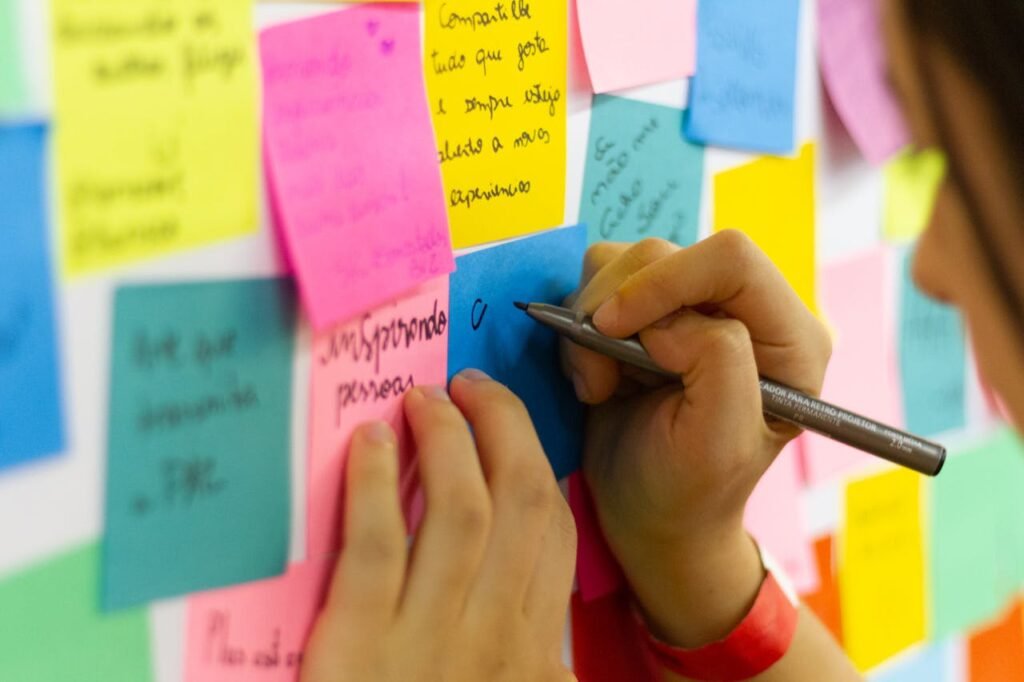7 PROVEN STUDY TECHNIQUES TO EXCEL IN YOUR EXAMS

Studying effectively is not just about reading from textbooks or cramming facts into your head; it’s about applying techniques that are designed to enhance your learning and remembering abilities. So, whether you have an important exam coming up or whether you are simply trying to get better in school, the right studying techniques can make a crucial difference.
The overwhelming number of methods that exist can certainly be difficult to navigate. With our current speed of life, we can’t rely on old-fashioned methods, such as cramming the night before or passively reading your notes anymore. If you want to be successful, you need studying methods that actively stimulate your brain, help you focus, and to help you retain information for when you need it. This is where the science-backed techniques and figures such as Ali Abdal, a productivity expert, come in handy.
Ali Abdal is a popular YouTuber and hugely successful Youtuber productivity expert who has shared several tips for studying smarter, not harder. Some specific strategies include active recall and spaced repetition, which have been adopted by thousands of students around the globe and are aligned with cognitive science research. Effectiveness of the methods and techniques are based on decades of studies on how our brains learn and retain information.
Although Ali is a valuable source in providing expert advice, he is not the only option. Approaches like the Pomodoro Technique and the Feynman Method have also shown to improve your studies and prevent fatigue. This article will take a look at seven engaging study techniques that utilize both expert advice and scientific studies to improve the efficiency and effectiveness of your studying.
Let’s jump into the seven techniques and find ways to unlock the full extent of your abilities in learning!
1. Active Recall
Active recall is one of the data driven and most powerful studying techniques. Active recall does not rely on passive studying habits like rereading your notes or highlighting text, but instead actively challenges each part you are studying, while ultimately strengthening those neural connections that will prime your retention of the material.
Because it is adding additional engagement, it will be a more efficient and lasting method of learning. The concept is simple and straightforward. Instead of simply reviewing your studying materials you take the information you have learned and challenge yourself with that information.
For instance, after you have read a chapter of a textbook, then, if necessary, put the textbook away and summarize what you can remember about the chapter overall. The more difficult the intersection of memory recall is, the better it is to increase learning outcomes. The active effort of pulling that information out of your brain reinforces your understanding of the material and keeps the information fresh in your memory.
Studies demonstrate that engaging in active recall aids in memory retention. Research conducted by cognitive scientist Dr. John Dunlosky and his team indicated that active recall, particularly when paired with spaced repetition, is among the most effective ways to retain information for the long-term.
This combination has also been shown to improve test and quiz performance because it allows your brain to “practice” recalling the material over longer intervals. To use recall to your advantage, utilize flashcards or regularly quiz yourself on the material. Smartphone apps like Anki or Quizlet allow you to create your own flashcard deck and set a routine of self-testing. The more you get your brain to work to recall the information, the more you will be able to retain.
2. Spaced Repetition
Spaced Repetition is perhaps the best strategy for remembering something in the long run. The idea is basic, but powerful. You’ll want to review the material you are trying to remember at spaced intervals, or we could say, as the time between each review gets longer and longer, you’ll retain that information a lot better than if you were to cram it.
Cramming is about short term retention, while Spaced Repetition is about moving information from our short term memory to permanent long-term memory for the times we need it. Spaced Repetition works with what researchers call the “spacing effect”. That means we can remember information much longer if we review it after longer and longer periods of time.
First, we will review the material fairly soon after we learn something, and then start to space out the time between our sessions, longer and longer each time. For example, we might review something a day after we learned it, then a week later, then a month later, and this will help to solidify the material into our memory and significantly lower the chance of forgetting it.
I used spaced repetition while I was studying, and I can wholeheartedly say it works. It will help you remember, and more importantly, retrieve complex concepts on exams. I have Ali Abdal to thank for leading me to this type of retention revolution, and he mentions this quite often in his videos!
Watch this video by Ali Abdal where he explains these tips in detail.
Anki is one of the best methods for using spaced repetition. Anki is a flashcard app that has a built-in scheduling system that provides you with intervals to review each card depending on how well you remember the information.
There are other apps that use similar scheduling algorithms to maximize retention over time, such as Quizlet or Memrise. Incorporating spaced repetition into your studying will ultimately lead to a higher retention rate and better exam scores.
When you consistently study using spaced repetition or using an app like Anki, you will realize that information is sticking with you longer, and it will take less time to learn.
3. The Feynman Technique
The Feynman Technique, named after the physicist Richard Feynman, is an extremely useful way to understand and learn difficult topics. The premise is quite simple: teach it to someone else. If you can break it down into simple understandings for a third party, you’ve learned it.
There are four steps to the process:
- Choose a concept: Start with a concept. A topic that you want to learn more about.
- Teach it: Write out everything you know about the topic as if you are teaching it to a child. Be sure to use simple language and write it down in a logical manner that organizes the principles of the topic.
- Review and identify gaps: As you are explaining, you will likely realize there are parts of your concept you don’t quite understand. Return to other resources, books or material to fill in (add to) your notes.
- Simplify and refine: Go back to your teaching notes and rewrite your explanation knowing what you’ve learned.
The utility of the Feynman Technique is in its ability to highlight your weaknesses (knowledge gaps) and forces you to actively “work” with the document. It’s more than just memorizing the information, this is about understanding concepts deeply and sharing what you learned with someone else in a clear manner. The Feynman Technique is an effective way to learn difficult subject areas and I have personally used it and find it works faster than any other method.
4. The Pomodoro Technique.
The Pomodoro Technique is a popular practice for time management. Over the years, it has become very effective for productivity, focus, and attention. The Pomodoro Technique was developed in the late 1980s by Francesco Cirillo.
The main idea is to set specific time periods for the work or time periods (called Pomodoros, for the Italian word “tomato”). A Pomodoro generally lasts 25 minutes and is followed by a short break. The technique relies on a simple but effective premise – to achieve single-tasking, but also plan breaks built into your work schedule, so you do not burn out.
The idea is to allow you to continue to perform at a high level of productive performance and an optimal amount of time working at your task. How Does It Work? The steps in the Pomodoro Technique are:1 – Set Your Timer for 25 Minutes. Decide the task you will work on and set your timer for 25 minutes. Work on the task, non stop, until the timer (pomodoro) goes off. Do not focus on anything that would create distraction. 2 – Short Break: Once your 25 minute timer goes off after 25 minutes of focused work, take a break (usually 5 minutes).
You are welcome to stretch, grab some water, or take a quick walk. 3 – Repeat: After completing four Pomodoros or tasks, which amount to approximately 100 focused working time, you will take a longer break after the total time working.
Practical Tips for Using the Pomodoro Technique
Helpful Tips for Using the Pomodoro Technique :
Organize Tasks: Before beginning, write down a list of tasks, and prioritize tasks to separate the most important task for each Pomodoro.
- Using a Timer App: There are many Pomodoro timer apps, such as PomoDone, Focus Booster, or Be Focused, which will help you record your Pomodoro intervals and breaks.
- Be Accountable: If possible, have a study buddy or colleague work with you to keep each other accountable and motivated.
- Please Don’t Multitask: The Pomodoro Technique is meant to be time spent in deep focus, devoting it to one particular task at a time. Avoid jumping between tasks or checking your phone during the Pomodoros.
Reflect to Record Progress: At the end of each day, take a moment to reflect on how many Pomodoros you got through – this will help you to see your progress and revising as needed.
Why it works
The Pomodoro Technique is effective because it takes advantage of our brain’s natural tendency to focus deeply for brief periods, like 25 minutes. In a Pomodoro, you intensely focus on your work for the time limit (e.g., 25 minutes), after which you take a short break, allowing your brain to take a rest and preventing any mental fatigue.
Alternating between focus work and breaks will allow you to maintain productivity in your study or work session. Using the Pomodoro Technique as part of your study schedule can help to boost your focus, decrease procrastination, and increase productivity. Try it! You may be amazed by what you accomplish!
5. Mind Mapping

Mind mapping is a creative, visual way to organize and connect ideas to understand and recall them better. Mind mapping involves drawing a map or a diagram, on which an idea is drawn in the center of the page and associated with topics that reach out beyond the center. Each of the lines reflects either a main topic or related subtopic or detail, and those lines can continue moving out to smaller lines. Mind mapping connects information visually, making it easier to organize thoughts, identify relationships, and think creatively.
How Mind Mapping Works
- Identify a Central Idea: Get your one main idea/concept down in the center of your page. It can be a chapter topic, a project initiative, a research question, etc.
- Add Branches that Lead Out to Subtopics: Draw lines reaching out from the center to represent the major subtopics/concepts associated with the central idea. The branches can represent important themes or important topics you will reflect or write about.
- Add Detail to each Subtopic: Start adding lines that continue to break down subtopics into smaller point items that have more detail. The details can include facts, examples, or even related ideas.
- Colors and Images: Mind maps generally create a more impactful picture when you’re also able to use colors, symbols, and images to engage the visual element. By adding visuals, you associate your ideas with the visual imagery, aiding with memory.
Practical Tips for Effective Mind Mapping
- Use a Mind Mapping Software: Even if you will create a mind map on paper, using a digital tool like XMind, MindMeister, or Lucidchart will provide many useful digital features such as easy editing and sharing that can help to keep you organized.
- Keep It Simple: Don’t overwhelm your mind map with too much information. Use very informal keywords and phrases to keep the mind map clear and simple.
- Use Keywords: Try to focus on keywords, or brief phrases, rather than complete sentences. This will help you capture the essence of the concept without losing yourself in too much detail.
- Review and Change: After you finish creating your mind map, review your mind map to check if there are any gaps or connections you were not able to include. You can create new branches or return to problems you were not able to organize initially.
Why Mind Mapping Works
Mind mapping helps you to visualize information and organize content to enhance understanding and retention. Due to the visual nature of mind mapping, you can see how different bits of information connect together and fit as part of a whole. Mind mapping is also a great tool for active learning, making it a natural fit for brainstorming, problem solving or preparing for an exam.
Whether you are studying for a test or working through a complicated project, mind mapping allows you to better process and organize your organized thinking.
6. Interleaving
Interleaving is an effective study method that involves mixing different topics or subjects when studying. Instead of block studying (i.e., focusing on a single topic in each study session), you mix in different types of problems or concepts.
In order to do this your brain must continually retrieve information and apply it in multiple ways, this form of studying is more powerful because it promotes learning, and it also enhances the application of that learning to new situations.
How Interleaving Works
When you study multiple topics or skills in a single session, the brain has to work extra hard to distinguish between the topics, therefore forming retrieval connections from the information previously learned to that which is being learned.
If you are to study a topic such as math, instead of doing 20 relatively similar algebra problems in a row, you would mix in some geometry problems or some calculus problems. The task of having to work to differentiate between the types of problems results in a deeper processing type of learning experience, which promotes better retention of the material.
Why Interleaving Works
Interleaving works because research has shown that it leads to improved long-term retention and problem-solving success. Interleaving feels more difficult because you are not totally immersing or engulfing yourself in just one topic, and thus, while studying it can feel more difficult than blocking the same topic.
However, research has shown that learners who interleave have better learning outcomes than those who didn’t interleave. Interleaving forces you to retrieve and apply knowledge in multiple ways which strengthens your ability to recall information and apply it in the creative ways you’ve learned it.
Practical Tips for Interleaving
- Mix Subjects or Topics: For example, if you are studying for different exams, do not spend an entire session on one subject. Instead, alternate between subjects or topics regularly.
- Space Out Sessions: Plan to review topics again after a few days. Interleaving can help boost long-term retention, and spacing out study sessions even further or exchanging subjects/topics will help you retain more information.
If you make interleaving a part of your studying routine, you will increase your ability to retain and apply knowledge, anytime or anywhere.
7. Deep Work

Deep Work is a term created by author Cal Newport that refers to the ability to work on a cognitively demanding task without distraction.
It is the opposite of shallow work. Examples of shallow work include checking your email, browsing social media, etc. Deep work is immersing yourself in intense, relevant, and challenging work that requires your full attention.
The Effectiveness of Deep Work with distractions embedded into our lives today, deep work can allow you to produce better quality work in less time. Interruptions happen when you work on a single task in an uninterrupted block of time. When you give intentional and purposeful attention to a single task, you’ll be able to produce more work, while also being more creative.
Deep work allows you to accomplish more in a shorter period of time, and your performance will benefit as well. If you struggle with staying focused, check out this guide on building self-discipline. The benefits of deep work are rooted in the deliberate practice of focused attention, which leads to better mastery of topics.
How to Implement Deep Work into Your Routine
- Eliminate Distractions: Turn off notifications, close tabs, and create a quiet workspace.
- Time Block: Dedicate a set of hours every day to deep work. Start time blocks at 60-90 minutes and take breaks after each time block.
- Embrace Boredom: Do not give in to the feeling of switching to another task. Train your mind to remain focused.
As you build deep work into your routine, you will be able to handle complex work in an efficient and higher quality manner.
Studying means more than simply spending a LOT of time with your books. It means using smart, research-backed strategies that facilitate deep learning and greater retention.
Whether it is Active Recall, Spaced Repetition, and the Feynman Technique, or focus-enhancing approaches like Pomodoro & Deep Work, each of the techniques in this guide could more effectively inform the way you study. The best part? You do not have to use ALL of them to realize benefits. Pick one or two to start, based upon your style of learning, and it should improve the way you study.
I have used many of the strategies and can attest that they do work. Whether you are a high school or university student, using these hacks will improve your grades and allow you to remain productive and even enjoy the process of studying! If you’re trying to fix other areas of your life too, here’s a helpful read on how to take back control of your life.
Now it’s your turn: start learning how to take control of your studies today!




3 Comments on “7 PROVEN STUDY TECHNIQUES TO EXCEL IN YOUR EXAMS”